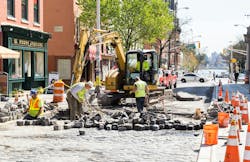The Responsibility We Share
By Mark Ludewig, Contributing Author
National Work Zone Awareness Week is crucial to our industry. It calls attention to the nonnegotiable responsibility we have to drive safely in work zones.
Since 1999, National Work Zone Awareness Week (NWZAW) has done more than bring attention to good driving habits. It’s helped to save lives and reduce injuries by raising awareness of dangers in and near work sites.
Coinciding with the start of construction season, NWZAW has grown to be recognized in all 50 states.
According to the latest National Highway Traffic Safety Administration (NHTSA) data, more than 950 people were killed and over 42,000 injured in work zone crashes in 2021.
And the trend is not abating. In fact, it’s getting worse. Work zone deaths have increased 46% since 2010, indicating we need better work zone driving awareness and new strategies to combat distracted vehicular habits.
While the number of fatalities is the most important factor to consider, there’s the added cost of injuries that creates lost time and the financial costs that result from delays on important infrastructure projects.
It’s a cascading effect that can be avoided, and it’s why weeks like this one are so important.
We can quantify these costs. Construction/maintenance workers suffer approximately 27,000 first-aid injuries and 26,000 lost-time injuries per year at a total cost of nearly $2.5 billion.
Meanwhile, motorists suffer approximately 52,000 property-damage-only accidents at a total cost of $6.2 billion per year due to highway work zone accidents.
In this way, accidents in work zones are doubly detrimental. They can be astronomical from a real-cost sense, not to mention any lingering debilitating psychological effects.
In the U.S. in 2017 alone, a total of 94,000 vehicular accidents occurred in work zones. The total economic impact of these crashes was estimated at nearly $17.5 billion—a figure which includes costs such as medical bills, lost wages, and property damage.
Trends are going in the wrong direction and costs are going up — and we as an industry must spread awareness to change course.
National Work Zone Awareness Week serves as a reminder for everyone to acknowledge and appreciate the efforts of highway maintenance staff. Even though many of us don't have direct contact with these essential workers, it's crucial to show our support for their commitment to maintaining critical infrastructure.
The safety of these workers is a constant concern for their loved ones, especially when they are out in the field. It's our collective responsibility to ensure their safe return home after each workday.
This observance also presents an opportunity for those involved in road maintenance to highlight safety practices within the industry. We should explore how we can further enhance the security of work zones and provide better training for our employees to handle potential dangers, such as stressing the need for essential safety gear like reflective attire.
The most effective strategy to combat hazardous and inattentive driving is through well-designed and executed work zones, incorporating state-of-the-art technology managed by professionals with safety training and certification.
Ultimately, our goal is for all workers to return to their families unharmed physically and mentally at the end of each workday.
Everyone plays a crucial role in minimizing the risk of injuries, deaths and health care expenses stemming from work zone incidents.
This involves showing respect for road workers, paying attention to signs, and adhering to traffic regulations within work zones.
Drive safe out there! RB
Mark Ludewig is AWP Safety’s vice president of Safety. AWP Safety plans and coordinates work zone projects requiring the use of sophisticated traffic control devices.
